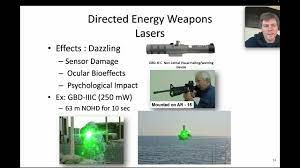Patent No. 6466185 Multi-planar volumetric display system and method of operation using psychological vision cues
Patent No. 6466185
Multi-planar volumetric display system and method of operation using psychological vision cues (Sullivan, et al., Oct 15, 2002)
Abstract
A multi-planar volumetric display system and method generate volumetric three-dimensional images using a multi-surface optical device including a plurality of individual optical elements corresponding to a plurality of image depths. An image projector selectively projects images on respective optical elements to generate a volumetric three-dimensional image viewable in the multi-surface optical device. Psychological vision cues are added during generation of the three-dimensional image to enhance depth perception when viewing the three-dimensional image. A floating-image generator may project the three-dimensional image having enhanced depth to generate a second volumetric three-dimensional image viewable as floating in space.
Notes:
Multi-planar
volumetric display system and method of operation using psychological vision
cues. Filed August 2001, granted October 2002. Funded by DARPA. Modify what
the patent says to use the data stream from the remote neural monitoring as
its input data stream. This patent says it does what it does with a 195 MHz
processor. Hmm, I think DARPA has some faster ones. Can be used to generate
virtual reality or holographic displays from separated and processed EEG stream/s
(separating various potentials and 'noise' and interpreting them). Basically
the psychological cues that the patent makes reference to in order to generate
the displays, would approximate what the Brain programmable display system does
with evoked potentials to create a display.
BACKGROUND
OF THE INVENTION
The present invention relates to three-dimensional (3D) imaging, and, more particularly,
to a multi-planar display system using 3D anti-aliasing for generating volumetric
three-dimensional images in space.
It is known that three-dimensional (3D) images may be generated and viewed to
appear in space. Typically, specialized eyewear such as goggle and/or helmets
are used, but such eyewear can be encumbering. In addition, by its nature as
an accessory to the eyes, such eyewear reduces the perception of viewing an
actual 3D image. Also, the use of such eyewear can cause eye fatigue which is
remedied by limiting the time to view the image, and such eyewear is often bulky
and uncomfortable to wear.
Thus, there is a need to generate volumetric 3D images and displays without
the disadvantages of using such eyewear.
Other volumetric systems generate such volumetric 3D images using, for example,
self-luminescent volume elements, that is, voxels. Before providing examples
of such systems, it is important to distinguish the much abused term "voxel"
from a 3D data element (referred to herein as a "tridel"). A voxel is the actual
glowing point of light in a 3D display and is analogous to a pixel in a 2D display.
However, a tridel is an abstract 3D data type. More specifically, voxels have
positions that are integers (i, j, k) and only have the properties of color
and brightness, whereas tridels are characterized by a set of parameters defined
at a floating point location (x, y, z) in a virtual image space. Thus, in its
most general sense, a tridel is a 3D data type any may encompass any number
of application-specific data types. For example, if the tridel is used to define
polygonal vertices of a 3D object then the data parameters of this abstract
3D data type are color (R, G, B) and visual opacity (A). As another example,
if the tridel represents a data element of an image produced by a medical computed
x-ray tomography ("CT") scanner, then the data parameter is x-ray opacity. In
yet another example, if the tridel describes a thermonuclear plasma, then the
data parameters might be plasma density, temperature, and average velocity of
the plasma constituents.
From the foregoing, it will be understood that to produce an image, either 2D
or 3D, each tridel must be mathematically processed into a pixel or voxel. This
processing may include geometric transformations including rotation, scaling,
stretching or compression, perspective, projection and viewpoint transformations,
all of which operate on the x, y, z coordinates of the tridel. Further, in the
process of determining the color and brightness of a pixel or voxel, tridels
may be averaged together when there are many within the space of one voxel or
interpolated between when there many pixels within the space of two tridels.
The distinction between tridels and voxels will be more clearly appreciated
upon consideration of the depth transformation discussed below for mapping the
depth coordinate of a tridel into the voxel depth coordinate within the MOE
device 32.
Turning to examples of other volumetric display systems known in the art, one
example of a volumetric image system is the system of 3D TECHNOLOGY LABORATORIES
of Mountain View, Calif., in which the intersection of infrared laser beams
in a solid glass or plastic volume doped with rare earth impurity ions generates
such voxel-based images. However, the non-linear effect that creates visible
light from two invisible infrared laser beams has a very low efficiency of about
1%, which results in the need for powerful lasers to create a bright image in
a large display. Such powerful lasers are a potential eye hazard requiring a
significant protective enclosure around the display. Additionally, scanned lasers
typically have poor resolution resulting in low voxel count, and the solid nature
of the volumetric mechanism results in large massive systems that are very heavy.
Another volumetric display system from Actuality Systems, Inc. of Cambridge,
Massachusetts, uses a linear array of laser diodes that are reflected off of
a rapidly spinning multifaceted mirror onto a rapidly spinning projection screen.
However, such rapidly spinning components, which may be relatively large in
size, must be carefully balanced to avoid vibration and possibly catastrophic
failure. Additionally, the size, shape, and orientation of voxels within the
display depends on their location, resulting in a position-dependent display
resolution.
Another volumetric display system is provided by NEOS TECHNOLOGIES, INC., of
Melbourne, Fla., which scans a laser beam acousto-optically onto a rapidly spinning
helical projection screen. Such a large spinning component requires a carefully
maintained balance independent of display motion. The laser scanner system has
poor resolution and low speed, drastically limiting the number of voxels. Additionally,
the size, shape, and orientation of voxels within the display depends on their
location, resulting in a position-dependent resolution. Finally, the dramatically
non-rectilinear nature of the display greatly increases the processing requirements
to calculate the different two-dimensional images.
Other types of 3D imaging system are known, such as stereoscopic displays, which
provide each eye with a slightly different perspective view of a scene. The
brain then fuses the separate images into a single 3D image. Some systems provide
only a single viewpoint and require special eyewear, or may perform headtracking
to eliminate eyewear but then the 3D image can be seen by only a single viewer.
Alternatively, the display may provide a multitude of viewing zones at different
angles with the image in each zone appropriate to that point of view, such as
multi-view autostereoscopic displays. The eyes of the user must be within separate
but adjacent viewing zones to see a 3D image, and the viewing zone must be very
narrow to prevent a disconcerting jumpiness as the viewer moves relative to
the display. Some systems have only horizontal parallax/lookaround. In addition,
depth focusing-convergence disparity can rapidly lead to eyestrain that strongly
limits viewing time. Additionally, stereoscopic displays have a limited field
of view and cannot be used realistically with direct interaction technologies
such as virtual reality and/or a force feedback interface.
Headmounted displays (HMD) are typically employed in virtual reality applications,
in which a pair of video displays present appropriate perspective views to each
eye. A single HMD can only be used by one person at a time, and provide each
eye with a limited field of view. Headtracking must be used to provide parallax.
Other display systems include holographic displays, in which the image is created
through the interaction of coherent laser light with a pattern of very fine
lines known as a holographic grating. The grating alters the direction and intensity
of the incident light so that it appears to come from the location of the objects
being displayed. However, a typical optical hologram contains an enormous amount
of information, so updating a holographic display at high rates is computationally
intensive. For a holographic display having a relatively large size and sufficient
field of view, the pixel count is generally greater than 250 million.
Accordingly, a need exists for high quality volumetric 3D imaging with computationally
acceptable demands on processing systems and which has improved viewability
and implementation.
In addition, in three-dimensional imaging, the use of discrete voxels renders
portions of images to appear jagged due to pixelization, for example, for features
at transitions between discrete depths in a volumetric 3D image. A need exists
for a method which softens the transition between portions of a volumetric 3D
image.
SUMMARY OF THE INVENTION
A multi-planar volumetric display (MVD) system and method of operation are disclosed
which generate volumetric three-dimensional images. The MVD system includes
a multi-surface optical device including a plurality of individual optical elements
arranged in an array; an image projector for selectively projecting a set of
images on respective optical elements of the multi-surface optical device; and
a floating-image generator for projecting the first volumetric three-dimensional
image from the multi-surface optical devices to generate a second volumetric
three-dimensional image viewable as floating in space at a location separate
from the multi-surface optical device.
Each of the plurality of the individual optical elements of the multi-surface
optical device includes a liquid crystal element having a controllable variable
translucency. An optical element controller is also provided for controlling
the translucency of the liquid crystal elements, such that a single liquid crystal
element is controlled to have an opaque light-scattering state to receive and
display the respective one of the set of images from the image projector, and
the remaining liquid crystal elements are controlled to be substantially transparent
to allow the viewing of the displayed image on the opaque liquid crystal element.
The optical element controller rasters through the liquid crystal elements at
a high rate during a plurality of imaging cycles to select one liquid crystal
element therefrom to be in the opaque light-scattering state during a particular
imaging cycle, and to cause the opaque light-scattering state to move through
the liquid crystal elements for successively receiving the set of images and
for generating the volumetric three-dimensional images with three-dimensional
depth.
The image projector projects the set of images into the multi-surface optical
device to generate the entire first volumetric three-dimensional image in the
multi-surface optical device at a rate greater than 35 Hz to prevent human-perceivable
image flicker. For example, the volume rate may be about 40 Hz. In one embodiment,
for example, if about 50 optical elements are used with a volume rate of about
40 Hz, the image projector projects each of the set of images onto a respective
optical element at a rate of 2 kHz.
The image projector includes a projection lens for outputting the set of images.
The projector also includes an adaptive optical focusing system for focusing
each of the set of images on the respective optical elements to control the
resolution and depth of the projection of the set of images from the projection
lens. Alternatively or in addition, the image projector includes a plurality
of laser light sources for projecting red, green, and blue laser light, respectively,
to generate and project the set of images in a plurality of colors.
In addition, a 3D anti-aliasing method is employed to smooth the portions of
the projected images at transitions between optical elements in the multi-surface
optical device. The anti-aliasing adjusts the display of voxels in a transition
between optical elements, such that color values of the voxels are modified
as a function of the distance of the voxels from the optical elements, to generate
a smooth transition between the portions of the volumetric three-dimensional
image.
-------------------------------
The
MVD system 10 may be implemented using the apparatus and methods described in
co-pending U.S. Provisional Patent Appln. No. 60/082,442, filed Apr. 20, 1998,
as well as using the apparatus and methods described in U.S. Pat. No. 5,990,990
filed Nov. 4, 1996, which is a continuation-in-part of U.S. Pat. No. 5,572,375;
which is a division of U.S. Pat. No. 5,090,789. The MVD system 10 may also he
implemented using the apparatus and methods described in co-pending U.S. patent
appln. Ser. No. 09/004,722, filed Jan. 8, 1998. Each of the above provisional
and non-provisional patent applications and issued patents, respectively, are
incorporated herein by reference. Accordingly, the invention has been described
by way of illustration rather than limitation.





Comments